Gas Chromatography
Gas Chromatography (GC) is a widely used analytical technique for separating and analyzing compounds in a mixture. It is based on the distribution and separation behavior of compounds in a flowing gas phase and a stationary phase. GC is typically employed for the analysis of volatile organic compounds but can also be used for the separation and quantification of non-volatile substances, provided they can be vaporized or converted into volatile derivatives under the analysis conditions.
The fundamental principle of GC involves the interaction between the mobile gas phase and the stationary phase, which is coated on the inner wall of a column. The separation is based on the compound’s distribution between the stationary and mobile phases, also known as equilibrium partitioning. The extent of a compound’s distribution between the two phases is influenced by its physicochemical properties, such as polarity, molecular weight, volatility, etc. As the mixture passes through the column, different compounds travel at different rates through the column and reach the detector for detection.
GC consists of several key components:
- Injector: The injector is used to introduce the sample into the column. The sample can be introduced as a gas or a liquid and is typically done using an automated sample injector for accurate and reproducible sample introduction.
- Column: The GC column is a long, narrow tube with the stationary phase coated on its inner wall. The selection of the column depends on the nature of the sample and the separation requirements. Common stationary phase materials include liquid phases and solid phases.
- Oven: The column oven is used to control the temperature of the column. It typically has an adjustable temperature range. The temperature selection is critical for the separation and analysis of specific compounds, as it influences the compound’s partitioning behavior in the column.
Detector: The detector is used to detect the separated compounds and generate corresponding signals. Common GC detectors include the flame ionization detector (FID), thermal conductivity detector (TCD), mass spectrometry detector (MSD), etc. Each detector has different sensitivities and selectivities towards specific types of compounds.
In GC analysis, the sample is typically subjected to pre-treatment steps such as sample extraction, derivatization, or concentration to enhance the volatility of the analytes or improve separation efficiency. The sample is then introduced into the injector, passes through the column for separation, and detected by the detector, generating signals. Through analysis and interpretation of the signals, the presence and concentration of different compounds in the sample can be determined.
GC offers high resolution, sensitivity, and a wide range of applications. It is widely used in various fields such as chemistry, environmental analysis, food analysis, pharmaceuticals, petroleum, and many others for analysis and quality control purposes.
GC Block Diagram
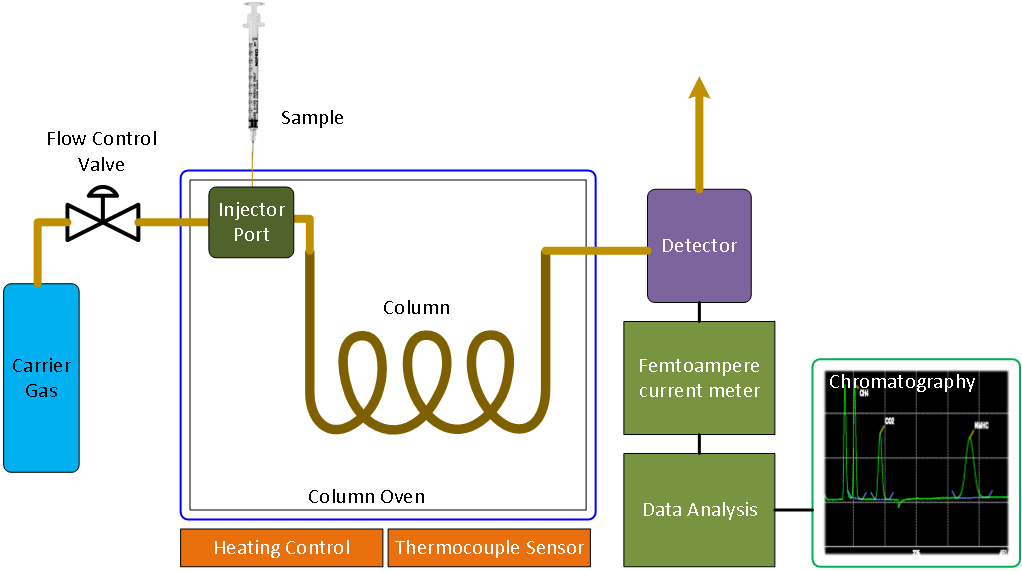
GC Control System for Semiconductor Applications
In semiconductor applications, a GC Control System is commonly used to analyze gases and volatile compounds involved in semiconductor processes to ensure process quality and safety. Here’s an explanation of a GC Control System specifically designed for semiconductor applications:
Contamination Control: Purity is critical in semiconductor processes. The GC Control System is used to monitor and control gases and volatile compounds in the process to detect any potential sources of contamination. It can quickly and accurately identify and quantify various gas components, such as organic solvents, volatile organic compounds (VOCs), etc.
Process Optimization: The GC Control System helps optimize various parameters in semiconductor processes. By monitoring the concentration and trend of key gas components, users can adjust process parameters for optimal results. For example, in chemical vapor deposition (CVD) processes, the system can monitor the supply of precursor gases to ensure uniform and consistent film deposition.
Detection and Troubleshooting: The GC Control System is utilized to detect gas contamination sources or abnormal conditions that may cause issues in semiconductor processes. The system can continuously monitor changes in gas composition and alert operators. When anomalies are detected, operators can quickly take corrective actions to troubleshoot and prevent quality problems or losses during the process.
Safety: Gases and volatile compounds used in semiconductor processes can pose hazards. The GC Control System provides safety features such as monitoring gas pressure, temperature, and flow rates to ensure a safe process environment. It can issue alarms and trigger safety measures such as automatic gas supply cutoff or activation of emergency exhaust systems to protect operator and equipment safety.
In summary, the GC Control System plays a crucial role in semiconductor processes by monitoring and controlling gas components, optimizing process parameters, detecting issues, and ensuring safety. Through detailed analysis and control, it helps improve process quality, reduce contamination risks, and enhance production efficiency.
GC in Advanced Semiconductor Process
GC plays a crucial role in advanced semiconductor processes by providing gas analysis capabilities. Here’s how GC can help in gas analysis for advanced semiconductor processes:
- Purity Analysis: In semiconductor manufacturing, the purity of gases used in various process steps, such as deposition or etching, is critical. GC can analyze and quantify impurities in the gas supply, ensuring that the gases meet the required purity standards. It can detect trace impurities and identify their composition, allowing for effective quality control and process optimization.
- Contamination Monitoring: GC is essential for monitoring and detecting gas contamination during semiconductor processes. It can identify and quantify unwanted gases or volatile organic compounds (VOCs) that may result from the chemicals used or from the process itself. Timely detection of contaminants can help identify the source of contamination and take corrective actions to ensure product integrity.
- Gas Mixture Analysis: Advanced semiconductor processes often require precise control of gas mixtures. GC can analyze and verify the composition of gas mixtures used in processes such as chemical vapor deposition (CVD) or gas diffusion. By accurately determining the gas mixture ratios, GC helps maintain process consistency and ensures that the desired film properties are achieved.
- Outgassing Analysis: During semiconductor manufacturing, materials and components can release volatile compounds, known as outgassing. GC can identify and quantify these outgassed compounds, which is critical for understanding their impact on device performance and reliability. By characterizing the outgassing behavior, GC aids in materials selection and process optimization.
Environmental Emissions Monitoring: Semiconductor fabrication facilities need to adhere to environmental regulations for gas emissions. GC can be used to monitor and analyze the gases emitted from semiconductor processes, such as by-products or waste gases. This helps ensure compliance with environmental regulations and enables proactive measures to minimize environmental impact.
By providing accurate and sensitive gas analysis capabilities, GC enables semiconductor manufacturers to maintain process control, optimize performance, and ensure product quality and reliability. It allows for efficient monitoring of gas purity, contamination, and emissions, contributing to the overall success of advanced semiconductor processes.
PPB level measurement in GC System
Achieving parts per billion (PPB) level measurements in a GC system requires careful consideration of various factors and optimization of analytical techniques. Here are some key strategies and techniques to achieve PPB level measurements:
- Sample Preparation: Effective sample preparation is crucial for achieving PPB level measurements. Sample pre-concentration techniques such as cryogenic trapping, purge and trap, or solid-phase microextraction (SPME) can be employed to enhance analyte concentration before injection into the GC system. These techniques help to improve sensitivity and detection limits.
- GC Column Selection: The selection of an appropriate GC column is critical for achieving PPB level measurements. Long and narrow-bore columns with high efficiency and low bleed characteristics are preferred. Columns with stationary phases specifically designed for target analytes or specific applications can provide better separation and lower detection limits.
- Temperature Control: Precise temperature control is essential for achieving PPB level measurements. Optimizing the column temperature profile can enhance separation efficiency and resolution. Elevated temperatures can improve analyte volatility and enhance the desorption process, leading to better peak shape and sensitivity.
- Detector Selection: The choice of detector plays a significant role in achieving PPB level measurements. Highly sensitive detectors such as electron capture detector (ECD), nitrogen-phosphorus detector (NPD), or mass spectrometry (MS) can be employed for improved detection limits and selectivity. These detectors offer higher sensitivity and lower detection thresholds for trace-level analysis.
- Calibration and Quality Control: Rigorous calibration and quality control procedures are necessary for PPB level measurements. Establishing calibration curves using certified reference standards is crucial for accurate quantification. Regular calibration checks and quality control measurements using standard reference materials ensure the reliability and traceability of measurement results.
- Purification Techniques: Depending on the application, additional purification techniques may be employed to reduce interferences and enhance detection limits. These techniques may include sample pre-treatment, such as solvent extraction or solid-phase extraction (SPE), to remove interfering compounds or matrix effects.
Blank Control: Stringent control of potential sources of contamination, such as instrument blanks and reagent blanks, is essential for achieving PPB level measurements. Regular blank measurements help identify and minimize background levels and improve the accuracy of trace-level measurements.
It’s important to note that achieving PPB level measurements in GC requires a comprehensive approach, including sample preparation, proper instrument setup, calibration, and quality control. Additionally, the choice of appropriate techniques and optimization parameters should be based on specific application requirements and the characteristics of target analytes.
Temperature Effect in GC system
Temperature plays a critical role in gas chromatography (GC) measurements and can significantly impact the analysis results. Here are a few key effects of temperature in GC measurements:
- Separation Efficiency: Temperature has a direct impact on the separation efficiency in GC. Adjusting the column temperature can influence the distribution behavior of analytes between the stationary phase and the mobile phase, affecting their retention times and separation. Typically, higher temperatures increase analyte volatility, resulting in faster migration through the column and improved separation.
- Peak Shape and Retention Time: Temperature variations can also affect peak shape and retention times in GC chromatograms. Higher temperatures may result in narrower and more symmetrical peaks with shorter retention times, while lower temperatures can lead to broader and more asymmetric peaks with longer retention times. Thus, proper temperature control is crucial for ensuring accurate retention times and well-defined peak shapes.
- Resolution: Temperature selection can impact the resolution of the GC analysis. Optimal temperature control can achieve better separation and resolution. Excessive or insufficient temperatures may result in inadequate separation, peak overlap, or poor resolution. Finding the appropriate temperature conditions for the specific analytes and column is vital to achieve the desired resolution.
- Detector Signals: Temperature variations can affect the signals generated by GC detectors. Certain detectors, such as thermal conductivity detectors (TCD), are sensitive to temperature changes. Therefore, precise temperature control is essential to ensure consistent detector signals and accurate measurements.
Column Lifespan: Temperature choice also influences the lifespan of GC columns. Excessive temperatures can damage or cause the degradation of the column, while extremely low temperatures may result in sample condensation on the column. Proper temperature selection and control can extend the column’s lifespan and ensure analysis stability.
Overall, temperature has significant effects on GC measurements. Proper temperature selection and control can enhance separation efficiency, peak shape, resolution, detector signals, and column longevity. Therefore, temperature is a critical parameter to consider and control in GC analysis to ensure reliable and accurate results.
VitalSigns VSC101 GC Control System
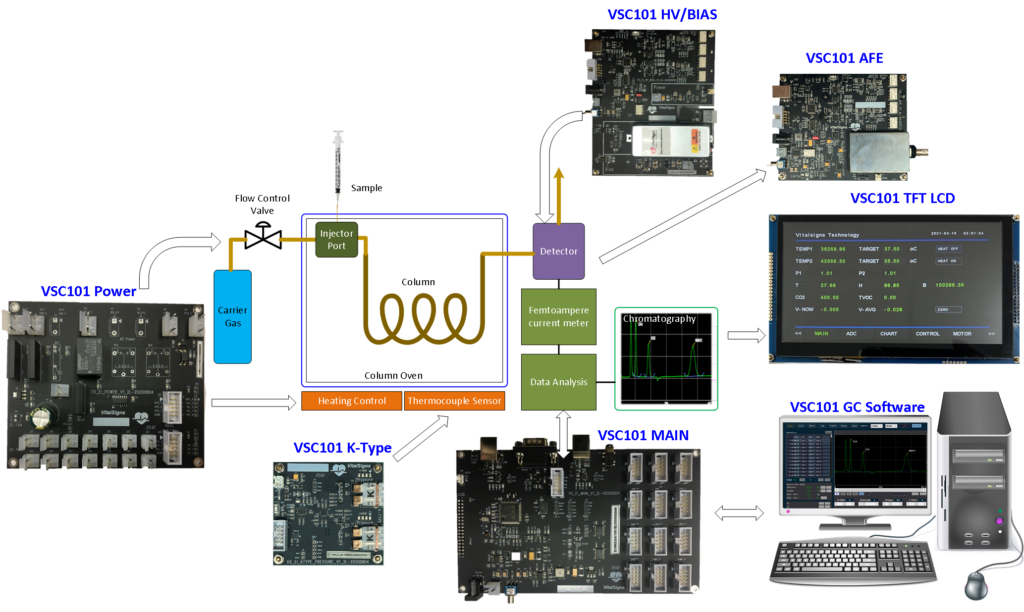
VSC101 Harware
GC Main Control Board
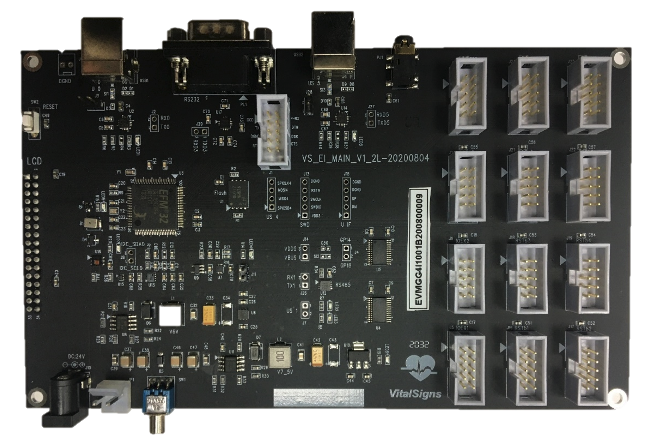
Function
- ARM Cortex-M4F @ 72M Hz
- USB to UART Interface
- RS485 Interface
- RS232 Interface
- Identify the Sample
- Heating control
- Valve control
- Programable GC Control flow
LCD & Touch Panel 7” TFT LCD
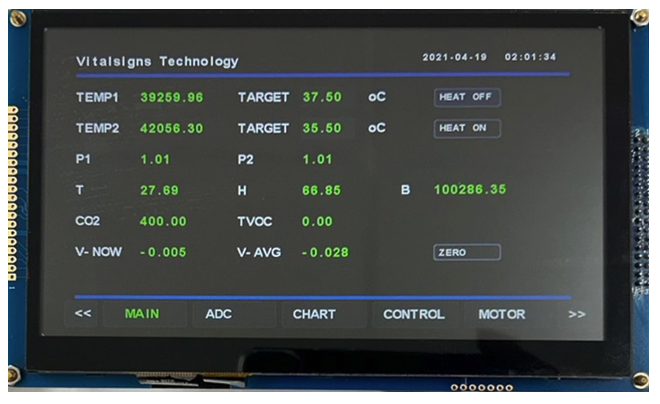
Function
- 1024×600 RGB
- Capacitance touch panel
- Parameter setting
- Gas Chromatogram chart display
Femtoampere Current Meter
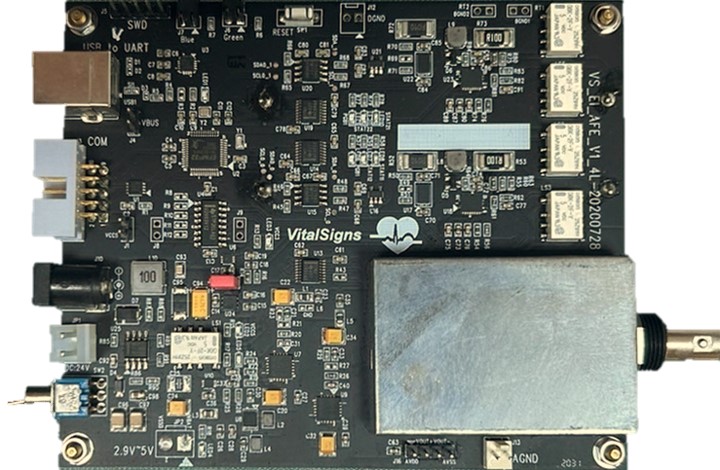
Function
- Femtoampere Current Meter
- Current Sense : 10G Ω
- ADC resolution : 24-bits, 5 Hz sampling rate
High Voltage & Bias Voltage Generator
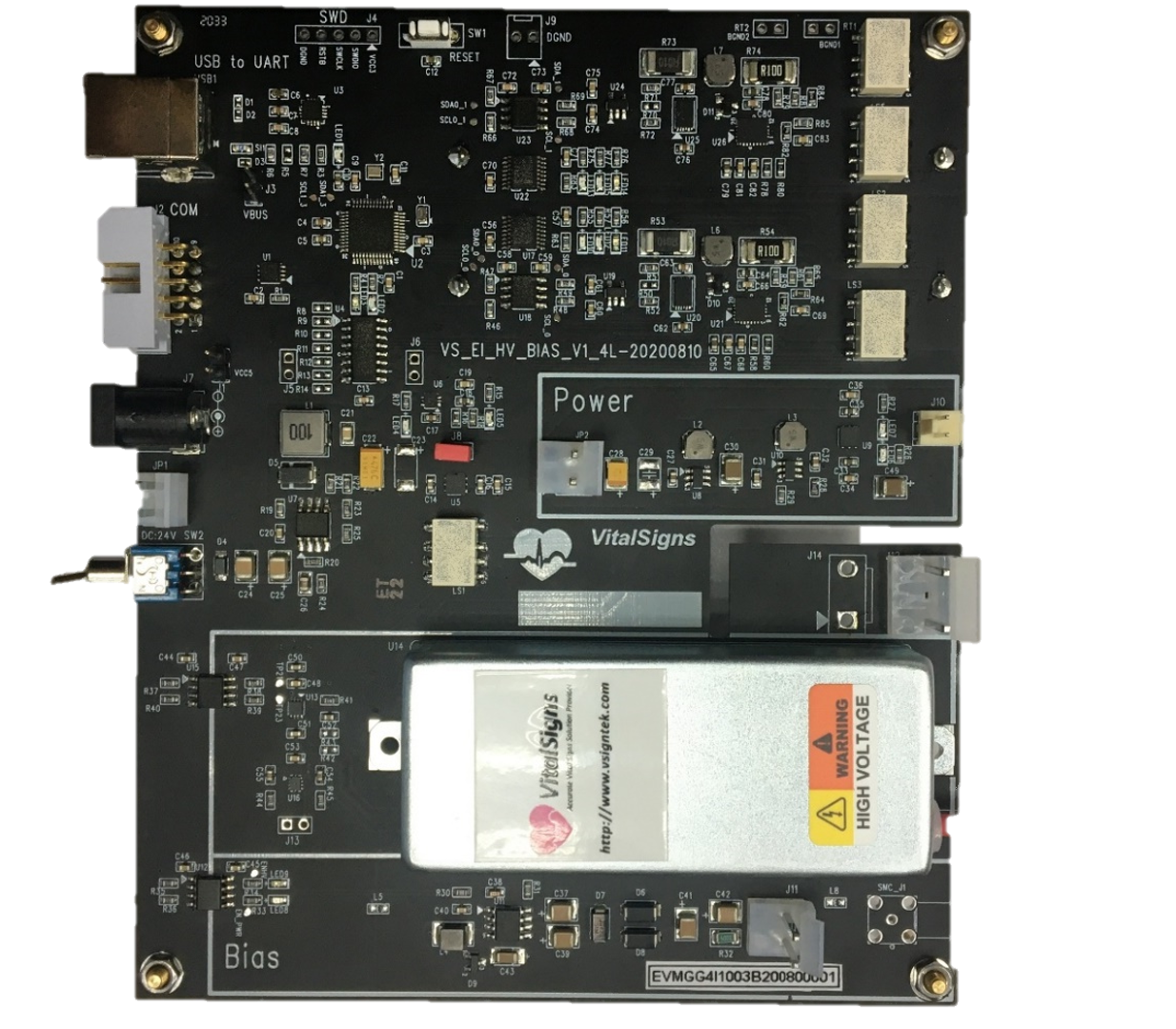
Function
- Programable High Voltage Generator : 0 ~ 10KV
- 200V Bias Voltage
K-Type Thermocouple meter
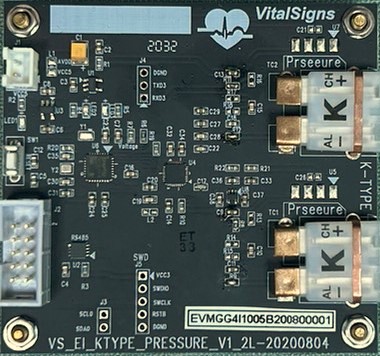
Function
- K-type Thermocouple x 2
Valve and Heating Control
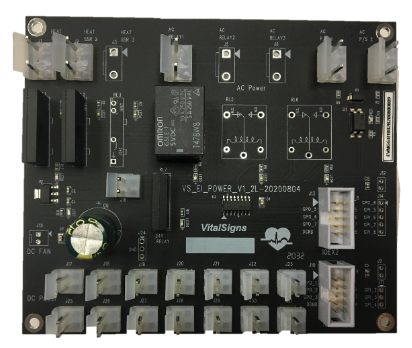
Function
- Power distribution unit
- Heating Solid State Relay x 2
- Valve Control Relay
VitalSigns Provides Solution of GC Control System
A GC control system designed for semiconductor applications aims to achieve precise gas analysis, which is critical for process control and quality assurance. The system combines elements such as instrument selection, temperature control, software and data management, calibration and quality control to provide efficient, accurate, and reliable gas chromatography for the semiconductor industry.
When designing a GC control system, the first step is to select GC instruments suitable for semiconductor applications. These instruments should offer high sensitivity, low detection limits, and appropriate column and detector options to meet specific analysis requirements.
Temperature control is a critical factor in achieving optimal separation and reproducibility in GC. Therefore, the GC control system should provide precise temperature control capabilities for the GC oven, injector, and detector to maintain stable operating conditions.
The control system also requires dedicated software interface for controlling the GC system and managing acquired data. The software should have user-friendly features including method setup, data acquisition, and analysis capabilities. Additionally, it should provide data storage, retrieval, and reporting functionalities for convenient data management.
Integration with semiconductor equipment is another important consideration for the GC control system, such as integration with chemical vapor deposition (CVD) systems or etching chambers. This integration allows real-time monitoring and control of gas compositions, enabling coordinated process control and synchronization.
To ensure accurate and reliable analysis results, the control system should provide features for calibration and quality control. This includes generating calibration curves, conducting routine calibration checks, and performing performance verification procedures to maintain analytical accuracy and instrument performance.
Safety and compliance are essential in a semiconductor environment. The control system should adhere to safety guidelines and offer features such as user access control, audit trails, and data integrity measures to ensure compliance with industry regulations.
In summary, a well-designed GC control system for semiconductor applications integrates elements such as instrument selection, temperature control, software and data management, calibration and quality control. This enables efficient, accurate, and reliable gas chromatography for process control and quality assurance in the semiconductor industry.
VitalSigns has exceptional expertise in the design aspects of GC control systems, particularly in femtoampere current measurement, GC data analysis, and heating control. With this expertise, VitalSigns can support clients in the development and design of GC control systems, including circuit design, firmware design, and upper-level software development. VitalSigns comprehensive capabilities ensure that clients receive tailored solutions for their GC control system needs.
If Interested, Please Contact
Please mail to sales@vsigntek.com
